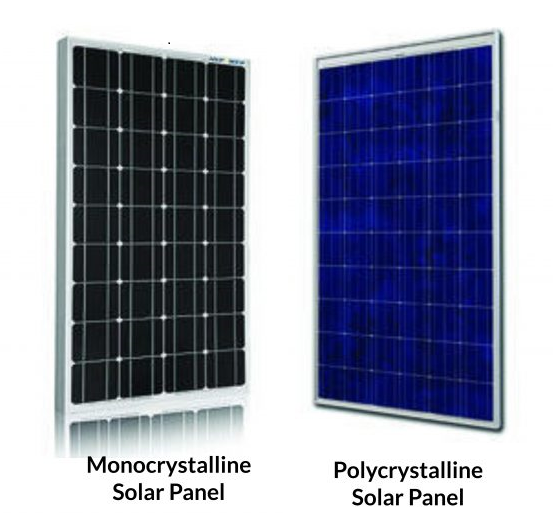WORKING OF SOLAR PV SYSTEM

COMPONENTS OF SOLAR
Solar Modules
The solar panels also known as PV Panel/Module generate DC (direct current) electricity from sunlight. Solar panels are made up with a bunch solar cells that convert sunlight into electricity. Solar cells are made from an element called “silicon. Solar panels are installed on shadow free area of the rooftop or ground usually facing south for maximum output.
Solar panels are invented in many types and capacities. These panel varies from each other based on their formation; material used. There are 2 types of Solar Panel: –

- Monocrystalline Solar Panels
Monocrystalline solar panels are often the most expensive due to the manufacturing process, which uses large amounts of highly purified silicon and a great deal of energy. Monocrystalline solar cells are about 19-20% efficient at converting sunlight to electricity.
- Polycrystalline Solar Panels
To manufacture polycrystalline solar panels, low purity silicon is used.Polycrystalline cell efficiencies range between 14-16% so polycrystalline are slightly less expensive than monocrystalline ones on a price-per-Watt basis.
Solar Inverter
A Solar Inverter is electrical equipment which converts the DC (direct current) electricity produced by the solar panels into AC (alternating current) electricity which is then used by the appliances or machines. Inverters play an important role in the solar energy system and are the brains of the project.Solar Inverter is the most important component of the solar system as it ensures that the maximum output of the solar panels is generated in all conditions.


Module Mounting Structure
Solar panels are mounted on iron fixtures so that they can withstand wind and weight of panels. The proper design of mounting structures is important to power plant performance as the power output from the PV plant will not be maximised if the mountings buckle and the panels are not optimally oriented towards the sun. In addition, improperly mounted panels present a ragged appearance that is not pleasing to the eye. Allowing sufficient air circulation to cool the PV panels is also an important factor that mounting structures should be designed



Solar Trackers
Tracking is a way of mounting the panels through a mechanism that allows the panels to follow the sun as it moves across the sky. Single-axis trackers follow the sun as it moves from East to West during the day, while dual-axis trackers also follow the sun on its North-South journey over the course of a year. Trackers can increase the power output from the PV plant but add significantly to both the initial cost of the plant and maintenance expenditure; utilization of trackers should be decided on a case-to-case basis after performing a cost-benefit analysis over the lifetime of the rooftop plant.
Bi-Directional Meter/Net Meter
The Bi-Directional Meter also called as “Net Meter” records how much electricity you send to and receive from the grid. As per the solar net metering policy in most of the states in INDIA, you will have to only pay for the difference in the electricity exported and imported every month.
Distribution Boxes
Distribution boxes in Solar PV system plays critical role in protecting electrical equipment’s from failures or any damages. There are 2 type of distribution box in Solar System.
- Solar ACDB
It gives extra protection to the system in case of failures on load side. ACDB includes necessary surge protection device (SPD) to protect the solar inverter from any type of damage or heavy
- Solar DCDB
is used to protect the system if there is any fault during failure on DC side.DCDB controls the DC power from Solar Panels and with having necessary surge protection device (SPD) and fuses to protect the solar panels strings and solar inverter from any type of damage.
